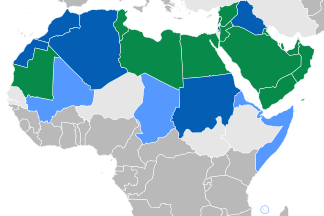Tunisia's unrest, which decisively shook, then removed an autocratic leadership, was clearly noticed around the Arab world. Within days, Egypt now finds itself in protracted unrest, something most analysts found rather unprecedented considering the iron hand shown going all the way back to Egyptian independence. (Gamal Nasser from the late 40s to 1970, Anwar Sadat's relatively brief reign from 1970 till his assassination in 1981, and now the current President Mubarak's 30 year reign.)
Street protests continue in Egypt despite a well equipped and experienced police force familiar with clamping down harshly when called upon.
Egypt, as the largest Arab country in the middle east, has always been viewed as a leader of Arab sentiment (excluding its separate peace with Israel), and that it could suddenly be on shaky ground has implications for many other Arab countries, Syria, Saudi Arabia and for that matter Libya, Western Morocco, Eritrea, and Yemen, which we'll focus on below.
Above, the regional bloc of countries that can loosely be classified as the "Arab world." Below, the broader collection of Muslim majority nations - religious character, not Arab ethnicity - includes Turkey, Iran, Bangladesh, Indonesia, Afghanistan, Pakistan and all the other 'stans we've covered in the past.
Two dynamics emerge: One, many Arab states can be viewed as nationalistic though autocratic entities where corruption and elitism leave little room for political expression, and two, Islamist states where religious absolutism reigns, though political and social repression is also the result.
The challenge we're seeing in Tunisia, Egypt, and Yemen follow this first path, with nervous observers most notably being Syria,and Saudi Arabia. The Islamist/religious challenge is seen in Lebanon most recently, the Palestinian discord between Fatah and Hamas, the long civil war in Sudan and its referendum, and in Iran (non-Arab, but Muslim). Iraq, Afghanistan, and Pakistan can also be sorted through these two prisms, but are heavily distorted by western military intervention. At this point only Turkey, Indonesia, and Jordan seem to have resonated with their populations well enough to avoid strong challenges (and two of those are non-Arab, though Muslim).
Lots of smaller Arab or Muslim nations could be sorted through the prism of reasonable governance vs corruption or Islamist challenges but we'll run out of space - Qatar, UAE, Kuwait, Bahrain, Oman, etc. Somalia deserves mention however, because it represents a corrupted leadership tolerated and supported because of Western geopolitics from the 60s till the 90s when it collapsed. Then, in a worst case scenario, a failed-state haven for Islamist extremists emerged (along with a commercial arm in the form of piracy).
Focusing a bit now, while the average Westerner knows at least a little about Egypt - pyramids, tourism, a warm social population, accomplished world citizens, and immigrants well dispersed throughout the world, what about Yemen? A quick overview of Yemen begins with its strategic location at the southern end of the Red Sea, and its recognized jurisdiction over over 200 islands along its shore. Wikipedia describes Yemen as one of the poorest and least developed countries in the Arab World, with a 65% employment rate (35% formally unemployed), dwindling natural resources, and a young and increasing population growth (approaching 30 million). Yemen's economy is weak compared to most countries in the Middle-East, mainly due to Yemen possessing very small quantities of oil, though the government depends heavily on the oil it produces for its revenue.
Yemen on the Southern corner of the Arabian Peninsula, across the Red Sea from Somalia, and generally out of world sight.
Most foreign observers agree that rampant corruption is a prime obstacle to development in the country, limiting local re-investments and driving away regional and international capital. In the last 5-6 years, an Islamist movement has taken advantage of the general stagnation and desperateness to embed itself in the mountains.
Street protests in Yemen's capital Sanna, are initially focusing on the autocratic reign of their President Ali Abdullah Saleh, ruler for more than 30 years.
The most notorious Islamist hiding somewhere in Yemen is the American born Anwar Al-'Awlaki. He emerged to the world's general awareness because of his role as the prime confidante of Major Nidal Hasan, the Muslim psychiatrist and US Army soldier who carried out November 2009's deadly shootings of thirteen individuals at Fort Hood Texas. Al-Alwaki is on the crosshairs (if one may still use the phrase, though in this case, this blogger believes it is literally true) of US anti-terrorist forces and officially of the Yemeni government.
Sheikh Al Alwaki and his shooting protege, US Army Major Nidal Hasan
At any rate, the tens of thousands of protesters in Yemeni's capital, Sanaa, are a microcosm of unrest elsewhere. They've had it with corruption and lack of hope, they suffer from poverty and lack of freedoms, and they want to get rid of their leadership, which has often found tacit support from the West in return for measured cooperation and stability. In the wings lies an Islamist movement and a lack of a history of measured responsible opposition that could govern alternatively.
The Arab world in 2011 is suddenly looking much more fluid. The protests legitimately target a stifling and corrupted governance, but the alternatives can easily go either well or strikingly worse.
Striking Yemeni architecture
Shibam, Yemen - population around 7000 (also known as the "Manhattan of the Desert"). Shibam owes its fame to its distinct architecture, and is now a UNESCO World Heritage Site. The houses of Shibam are all made out of mud brick but about 500 of them are tower houses, which rise 5 to 11 stories high, with each floor having one or two apartments (the tallest mud buildings in the world). In order to protect the buildings from rain and erosion, the façades are thickly coated and must be routinely maintained.
This is a big world, we happen to have been born into a dominant country, itself part of a prosperous and powerful Western civilization. We're "oversupplied" with news though it may not inform us well. "Six stories from seven continents" is a modest effort to remind ourselves there are snippets, events, and stories from all around the world to hear and learn from... that our awareness is incomplete, and life is breathtakingly more complex and wonderful than we usually imagine.
North Korea

The always bombastic and unpredictable North Koreans go hysterical again. This time the country is prepared to "go to war" with South Korea because that country is playing loudspeakers directed at North Korean territory. A headline from a UK paper reads, "More than 50 North Korea submarines 'leave their bases' as war talks with South continue "



No comments:
Post a Comment